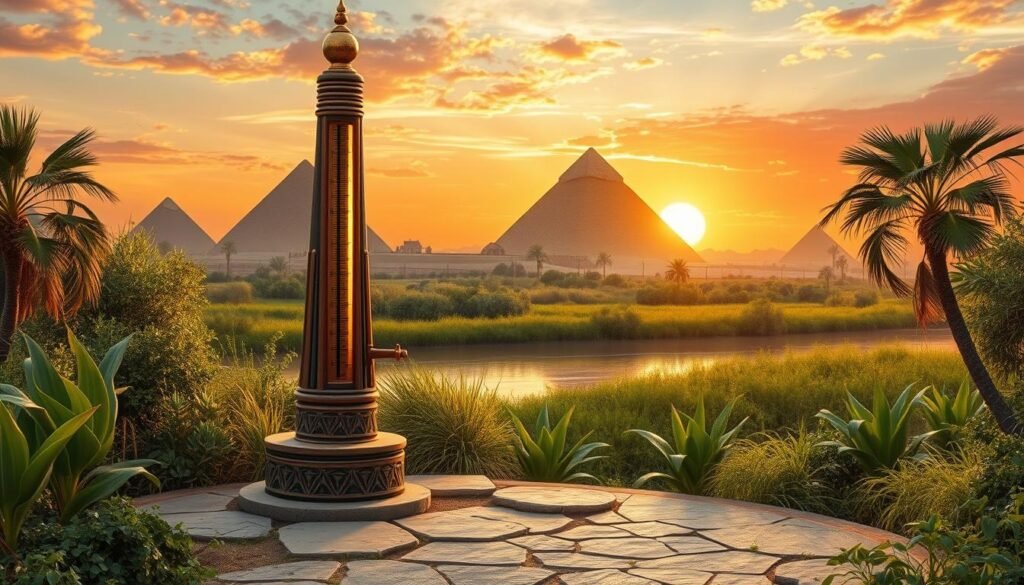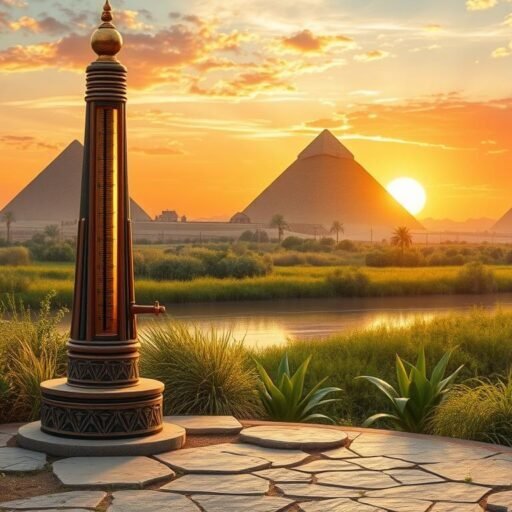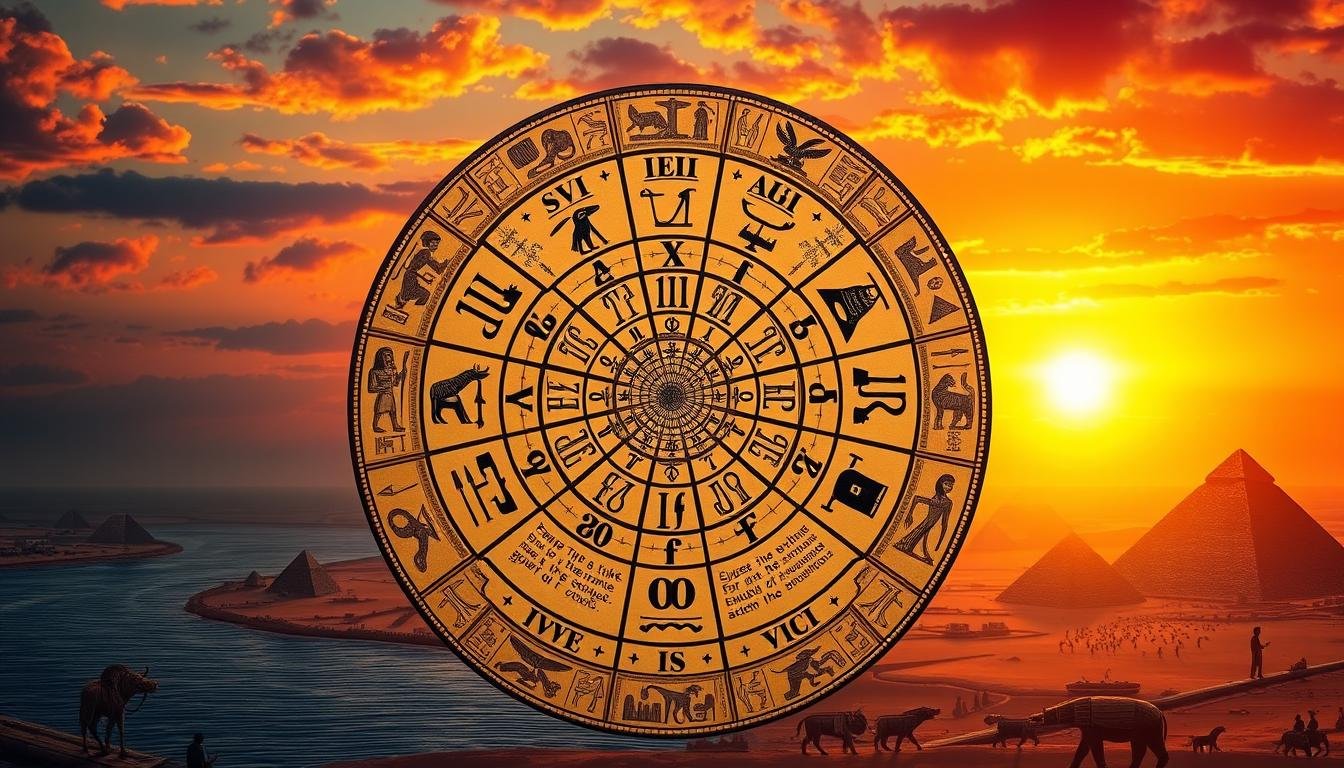In ancient Egypt, the calendar was more than a tool for tracking time. It was a sacred guide for daily life, farming, and religious events. Let’s explore how these ancient people kept time, just like the pharaohs did.
The Egyptian calendar was a masterpiece of science and math. It showed the Egyptians’ deep bond with the sky and its movements. They watched the sun, moon, and stars to create a complex system. This system was both practical and deeply meaningful to their culture and faith.
Key Takeaways
- The ancient Egyptian calendar was a sophisticated system of timekeeping that was closely tied to the natural world and celestial events.
- Egyptians used the calendar to track the flooding of the Nile, the agricultural seasons, and religious festivals.
- The calendar consisted of three main types: the civil, the lunar, and the sothic calendars, each with its own unique characteristics.
- The calendar’s development and evolution were influenced by the Egyptians’ deep understanding of astronomy and mathematics.
- The calendar’s cultural significance was woven into the fabric of ancient Egyptian society, shaping their agricultural practices, religious rituals, and daily life.
Understanding the Egyptian Calendar System
The ancient Egyptians had a complex calendar system. It was key to their daily lives. The system included three main types: the lunar, solar, and civil calendars.
The Three Main Calendar Types
The lunar calendar followed the moon’s phases. It had 12 or 13 months, each with 29 or 30 days. It was mainly for religious and administrative use.
The solar calendar tracked the sun’s yearly cycle. It had 365 days, divided into 12 months of 30 days each, plus 5 extra days. This calendar was for farming and civil needs.
The civil calendar mixed lunar and solar calendar elements. It had 365 days, with 12 months of 30 days each, and 5 extra days at year’s end.
Historical Development and Evolution
The Egyptian calendar system evolved over time. The earliest versions date back to the pre-dynastic period. As the civilization grew, the calendar became more complex, with new calendars and refinements.
Cultural Significance in Ancient Egypt
The calendar system was deeply cultural and religious. It was tied to the Nile River’s cycles, vital for farming. It also guided religious festivals and important events, like pharaoh coronations.
“The Egyptian calendar was a remarkable achievement, reflecting the ingenuity and astronomical knowledge of the ancient Egyptians.”
The Structure of the Ancient Egyptian Year
The ancient Egyptian calendar was very detailed. It had 12 months, each with 30 days. This made a 360-day year. Five extra epagomenal days were added at the end, making it 365 days.
Each month was split into three 10-day periods called decans. These were for keeping track of time and for religious events. The decans were based on stars, helping the Egyptians keep accurate time.
| Egyptian Months | Duration (Days) |
|---|---|
| Thoth | 30 |
| Paophi | 30 |
| Hathor | 30 |
| Khoiak | 30 |
| Tybi | 30 |
| Mechir | 30 |
| Phamenoth | 30 |
| Pharmuthi | 30 |
| Pachons | 30 |
| Payni | 30 |
| Epiphi | 30 |
| Mesore | 30 |
The epagomenal days at the year’s end were sacred. They were for religious celebrations and rituals. These five days were not in any month, keeping the calendar at 365 days.
This system of Egyptian months, decans, and epagomenal days was key to ancient Egyptian life. It helped with farming, religion, and government.
Seasons and Agricultural Cycles in Egyptian Timekeeping
Ancient Egyptians knew the natural world well. They understood the Nile’s flooding and how it affected their lives. This knowledge was key to their timekeeping and daily activities.
The Flooding Season (Akhet)
The first season, Akhet, was when the Nile flooded. It lasted from June to October. During this time, the land was rich and ready for planting.
Growing Season (Peret)
After the flood, the Peret season began. It lasted from November to February. Farmers planted their crops in the fertile soil left by the flood.
Harvesting Season (Shemu)
The Shemu season came last, from March to May. It was for harvesting. The Egyptians gathered their crops and prepared for the next flood. They also watched for the star Sirius to plan their farming.
The Egyptians’ knowledge of the seasons and the Nile was impressive. It showed their skill in farming and their connection to nature. This understanding shaped their timekeeping, culture, and religion.
Sacred Months and Religious Observances
The ancient Egyptian calendar was more than just a way to keep track of time. It was deeply rooted in their religious and cultural life. Each month was tied to special festivals and celebrations for their gods.
The start of sacred months was tied to the stars and the land’s cycles. For example, Thoth’s month (July-August) kicked off the year. It honored Thoth, the god of writing and time. People came together to celebrate the Nile’s flood, key for their farming.
- Khoiak (October-November) was a time for mourning and new beginnings, honoring Osiris.
- The Opet festival in Epiphi (August-September) was a major event. It honored Amun, Mut, and Khonsu, the divine trio.
- Pakhons (April-May) celebrated Bastet, the goddess of women and children, and Ra, the sun god.
These Egyptian festivals and deity celebrations were central to their religious calendar. They showed the strong link between time and spirituality in ancient Egypt.
“The gods’ calendar was the foundation of the ancient Egyptian worldview, and the priests’ ability to accurately predict the timing of religious observances was essential to maintaining cosmic order.”
Egyptian Calendar Calculations and Mathematics
The ancient Egyptians were known for their skills in astronomy and math. These skills were key to their calendar system. They could track the sky and predict seasons and crops, crucial for their survival.
Astronomical Observations
The Egyptian calendar was based on careful sky watching. Priests and astronomers tracked the sun, moon, and stars. They used this info to keep the calendar accurate.
The star Sirius, or the “Nile Star,” was very important. It signaled the start of the Nile flood and the new year.
Mathematical Methods Used
- The Egyptians used math to figure out the year and celestial events.
- They had a 365-day calendar with 12 months of 30 days each. They added 5 extra days at the end.
- They made adjustments over time to match the solar year better.
Priest’s Role in Timekeeping
The priests were in charge of the calendar. They were experts in Egyptian astronomy and mathematics. Their priestly duties included watching the sky, doing math, and keeping the calendar in sync with nature.
| Astronomical Observation | Mathematical Calculation | Priestly Role |
|---|---|---|
| Monitoring the movements of the sun, moon, and stars | Determining the length of the year and the timing of celestial events | Maintaining the calendar’s accuracy and alignment with natural cycles |
| Tracking the annual rising of Sirius, the “Nile Star” | Adjusting the 365-day calendar to account for the true solar year | Ensuring the calendar’s continuous relevance and usefulness for the Egyptian civilization |
The Rise of the Nile and Calendar Predictions
In ancient Egypt, the Nile River’s annual flood was key to their lives. The people knew how crucial it was to predict the flood’s timing. This was vital for planning their crops and keeping their civilization thriving.
The Egyptians used the Nilometer to track the Nile’s water levels. These structures, built along the Nile, had markings to measure the water’s height. Priests and scholars could then use this data to make accurate predictions.
| Nilometer Function | Impact on Calendar Predictions |
|---|---|
| Measuring Nile flood levels | Allowed for accurate flood predictions and agricultural planning |
| Tracking seasonal patterns | Enabled the development of the Nilometer calendar, which synchronized with the annual flooding cycle |
| Predicting harvest yields | Helped Egyptians anticipate and prepare for agricultural needs |
The Egyptians used the Nilometer to predict the Nile’s floods and plan their crops. This allowed them to align their calendar with the Nile’s flooding. This ensured their crops were planted and harvested at the best times.

The Nilometer was crucial in ancient Egyptian society. It helped them manage their crops and keep their civilization stable for centuries.
Comparing the Egyptian Calendar to Modern Systems
The ancient Egyptian calendar lasted for thousands of years. It’s different from the Gregorian calendar we use today. Knowing these differences helps us understand the Egyptian calendar’s lasting impact.
Differences from the Gregorian Calendar
The Gregorian calendar was introduced in 1582. It’s based on the sun and has 365 days in a regular year. The Egyptian calendar, however, was based on the moon and had 360 days in a year.
This made the Egyptian calendar drift away from the solar year. It needed regular updates to stay in sync.
Legacy and Modern Applications
Even though the Egyptian calendar is different, it still influences how we keep time today. The idea of a 12-month year and seasons comes from the Egyptians. These ideas are found in calendars like the Gregorian and Julian.
The Egyptian calendar’s focus on math and astronomy also helped create more accurate calendars. This shows how their work has shaped our timekeeping.
| Feature | Egyptian Calendar | Gregorian Calendar |
|---|---|---|
| Calendar Type | Lunar-based | Solar-based |
| Number of Days per Year | 360 | 365 (366 in leap years) |
| Number of Months per Year | 12 | 12 |
| Calendar Reforms | Periodic, to keep in sync with solar year | Introduced in 1582 to correct the Julian calendar’s drift |
In summary, the ancient Egyptian calendar has greatly influenced how we keep time today. Its legacy shows the ancient Egyptians’ wisdom and skill in astronomy.
Decoding Ancient Egyptian Date Markings
Exploring ancient Egyptian timekeeping means learning about their hieroglyphics and Egyptian numerals. These symbols on monuments and papyri show their advanced calendar. It was used by pharaohs and their people.
The ancient Egyptians had a complex date inscription system. It recorded events, religious days, and official records. Knowing this code helps us understand ancient texts.
- Egyptian Numerical System: They used base-10 numbers, with symbols for units, tens, hundreds, and thousands. These symbols were mixed to show bigger numbers.
- Hieroglyphic Date Markings: Dates were written with hieroglyphics and Egyptian numerals. The symbols meant things like the Nile’s flooding or Sirius rising.
- Interpreting Date Inscriptions: Scholars can figure out the exact date on artifacts or monuments by knowing the symbols and numbers.
| Hieroglyphic Symbol | Numerical Value | Meaning |
|---|---|---|
| 1 | Year | |
| 10 | Month | |
| 1 | Day |
Learning to read these hieroglyphics and Egyptian numerals lets scholars reveal the past. They find out about the ancient Egyptians’ lives and cycles.
How Egyptians Used Stars for Calendar Tracking
The ancient Egyptians were skilled astronomers. They used the stars to track time and map the sky. Their calendar system relied on the Sirius star, also known as the Dog Star. It was key in starting their new year.
Sirius and the New Year
The Egyptians watched the heliacal rising of Sirius closely. This is when Sirius first appears just before sunrise. It marked the start of the Nile River’s flood, vital for farming.
By linking their calendar to Sirius’s rising, they could predict the flood season. This helped them plan planting and harvesting.
Constellation Mapping
- The ancient Egyptians mapped the night sky, identifying and naming various constellations that they used for timekeeping and navigation.
- One of the most significant constellations was the Orion, which they associated with the god Osiris. The rising of Orion was closely linked to the heliacal rising of Sirius, further reinforcing the importance of this star in their calendar system.
- Other prominent constellations included the Big Dipper and the Northern Crown, which the Egyptians utilized for their seasonal and celestial observations.
The ancient Egyptians’ mastery of Sirius star, heliacal rising, and constellation mapping shows their advanced understanding of Egyptian astronomy. This knowledge helped them create a reliable calendar system. It was crucial for their farming and religious activities.
Modern Understanding of the Egyptian Calendar
In Egyptology, scholars have made big strides in understanding the ancient Egyptian calendar. They’ve dug deep into historical records to learn more about this timekeeping system. This system once guided the pharaohs’ lives.
Efforts to rebuild the Egyptian calendar have given us new insights. Researchers have analyzed astronomical observations, math, and texts. This has helped us see how the Egyptians tracked time and celebrated rituals.
This work has also made us appreciate the ancient Egyptians’ science and culture more. The modern view of the Egyptian calendar has also sparked interest in its impact on today’s calendars. As we learn more, we see the ancient Egyptians’ genius and sophistication.

